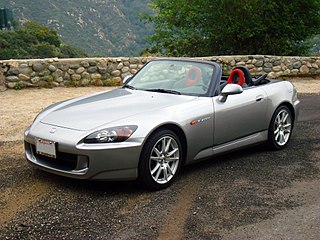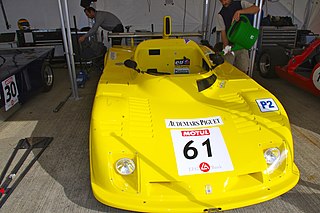
Abarth & C. S.p.A. is an Italian racing and road car maker and performance division founded by Italo-Austrian Carlo Abarth in 1949. Abarth & C. S.p.A. is owned by Stellantis through its Italian subsidiary. Its logo is a shield with a stylized scorpion on a yellow and red background.
Power-to-weight ratio is a calculation commonly applied to engines and mobile power sources to enable the comparison of one unit or design to another. Power-to-weight ratio is a measurement of actual performance of any engine or power source. It is also used as a measurement of performance of a vehicle as a whole, with the engine's power output being divided by the weight of the vehicle, to give a metric that is independent of the vehicle's size. Power-to-weight is often quoted by manufacturers at the peak value, but the actual value may vary in use and variations will affect performance.

The Honda S2000 is an open top sports car that was manufactured by Japanese automobile manufacturer Honda, from 1999 until 2009. First shown as a concept car called the SSM at the Tokyo Motor Show in 1995, the production version was launched on April 15, 1999, to celebrate the company's 50th anniversary. The S2000 is named for its engine displacement of two liters, carrying on in the tradition of the S500, S600, and S800 roadsters of the 1960s.
Honda Type R models are special performance editions of their respective model families.
Osella is an Italian racing car manufacturer and former Formula One team. They participated in 132 Grands Prix between 1980 and 1990. They achieved two points finishes and scored five championship points.

The Honda K-series engine is a line of four-cylinder four-stroke car engine introduced in 2001. The K-series engines are equipped with DOHC valvetrains and use roller rockers on the cylinder head to reduce friction. The engines use a coil-on-plug, distributorless ignition system with a coil for each spark plug. This system forgoes the use of a conventional distributor-based ignition timing system in favor of a computer-controlled system that allows the ECU to control ignition timings based on various sensor inputs. The cylinders have cast iron sleeves similar to the B- and F-series engines, as opposed to the FRM cylinders found in the H- and newer F-series engines found only in the Honda S2000.
Since its inception in 1947, Formula One has used a variety of engine regulations. "Formulae" limiting engine capacity had been used in Grand Prix racing on a regular basis since after World War I. The engine formulae are divided according to era.

The Honda Civic Type R is a series of high-performance hatchback/sedan models based on the Civic, developed and produced by Honda since September 1997. The first Civic Type R was the third model to receive Honda's Type R badge. Type R versions of the Civic typically feature a lightened and stiffened body, specially tuned engine, and upgraded brakes and chassis, and are offered only in five- or six-speed manual transmission. Like every other Type R models, red is used in the Honda badge background to give it a special sporting distinction and to separate it from other models.

The Evolution Championship Series, commonly known as Evo, is an annual esports event that focuses exclusively on fighting games. The tournaments are completely open and use the double elimination format. As with Super Battle Opera, contestants travel from all over the world to participate, most notably from Japan. The first Evolution was originally held as a Super Street Fighter II Turbo and Street Fighter Alpha 2 tournament called the Battle by the Bay. It changed its name to Evo in 2002. Every successive tournament has seen an increase of attendees. It has been held at various venues across the Las Vegas Valley since 2005. As of 2021, the event is jointly owned by Sony Interactive Entertainment and the Endeavor esports venture RTS.

JAS Motorsport is an Italian motor racing team and an engineering and manufacturing company. It was founded in 1995 by Paolo Jasson, Maurizio Ambrogetti and Giorgio Schon. The company initially competed with Alfa Romeo in 1996 and 1997. Since 1998, they have been an official partner of Honda, and have developed, built and raced cars in various different disciplines for the Japanese manufacturer, as well as provided customer racing services.

The second generation Honda NSX, marketed as the Acura NSX in North America, China and Kuwait, is a two-seater, all-wheel drive, mid-engine hybrid electric sports car developed and manufactured by Honda in the United States. Production began in 2016 and ended in 2022 with the Type-S variant. It succeeds the original NSX that was produced in Japan from 1990 until 2005.
The Catania-Etna is a car competition, more precisely a hillclimb, which takes place annually in province of Catania. It is valid for the Cronosprint Trophy. It is organized by the Automobile Club d'Italia of Catania.
The Osella PA2 is a 2-liter Group 5 prototype racing car built by Osella, to compete in the World Sportscar Championship sports car racing series from 1974 to 1975, but was used in active competition IMSA GT Championship until the end of 1985. It was initially powered by either the 2.0 L (120 cu in) Abarth twin-cam engine, or later, the BMW M12/7 Turbo engine.

The Osella PA3 is a Group 6 prototype racing car designed, developed, and built by Osella, to compete in the World Sportscar Championship sports car racing series in 1975, but was used in active competition through 1986. It was powered by a number of different engines, including the 2.0 L (120 cu in) BMW M12/7, the Abarth twin-cam engine, and the Cosworth BDG, or the 1.3 L (79 cu in) Cosworth BDH, or even the smaller the smaller 998 cc (60.9 cu in) Cosworth SCA. The 1.6 L (98 cu in) and 1.8 L (110 cu in) Cosworth FVA and Cosworth FVC were also used. It was even powered by a Ferrari 2.0 V8 engine.

The Osella PA4 is a Group 6 prototype racing car designed, developed, and built by Osella, to compete in the World Sportscar Championship sports car racing series between 1976 and 1980. It was powered by a number of different engines, including the 2.0 L (120 cu in) BMW M12/7, and the Cosworth BDG. The 1.6 L (98 cu in) and 1.8 L (110 cu in) Cosworth FVA and Cosworth FVC were also used. It was even powered by a Ferrari 2.0 V8 engine.

The Osella PA5 is a Group 6 prototype racing car designed, developed, and built by Osella, to compete in the World Sportscar Championship sports car racing series between 1977 and 1981. It was powered by a number of different engines, including the 2.0 L (120 cu in) BMW M12/7, Hart 420R, and the Cosworth BDG. The 1.6 L (98 cu in) and 1.8 L (110 cu in) Cosworth FVA and Cosworth FVC were also used. It was even powered by a Ferrari 2.0 V8 engine.

The Osella PA6 and Osella PA7 are Group 6 prototype racing car designed, developed, and built by Osella, to compete in the World Sportscar Championship sports car racing series between 1978 and 1982. It was powered by a number of different engines, including the 2.0 L (120 cu in) BMW M12/7 and the Cosworth BDG, and the 1.6 L (98 cu in) Cosworth FVA was also used. After retiring from sports car racing, these cars later competed in hillclimb racing.

The Osella PA20 and Osella PA20/S are Group CN sports prototype race cars, designed, developed and built by Italian manufacturer Osella; which was first made in 1994. As per the Group CN rules of a displacement being no larger than 3.0 L (180 cu in), it is powered by a specially tuned and modified naturally-aspirated BMW S50B30 straight-six engine, producing between 370–400 hp (280–300 kW), and is capable of revving over 10,000 rpm. It weighs 605 kg (1,334 lb). It has competed mostly in timed hillcimb events and trials, but in its road racing career, it scored a total of 2 race wins, 4 podium finishes. It was briefly converted to a WSC, to comply with the FIA's regulations.

The Osella PA21 is a series of Group CN sports prototype race cars, developed and built by Italian manufacturer Osella. The cars mostly compete in hillclimb races, trials, and events. They are commonly powered by, and designed to be equipped with either a naturally-aspirated 2.0 L (120 cu in) Honda K20 engine, producing in excess of 250 hp (190 kW), or a motorcycle engine, in the displacement range of 1.0–1.6 L (61–98 cu in), such as a Suzuki Hayabusa, or an S1000RR motor.

Samastha Kerala Jem-iyyathul Ulama,–present, is the principal Sunni-Shafi'i scholarly body in Kerala. The council administers Shafi'ite mosques, institutes of higher religious learning and madrasas in india.














